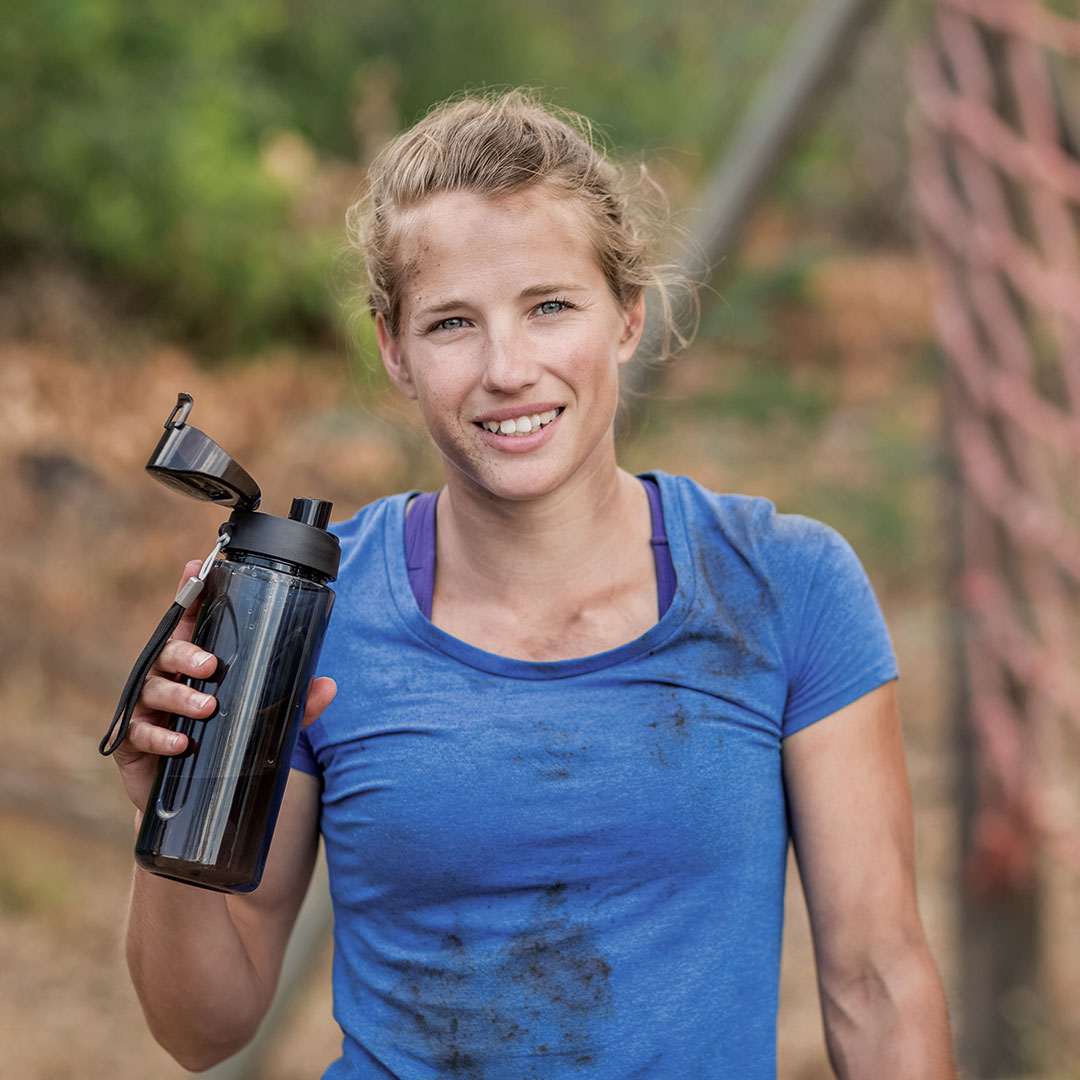
With rising temperatures and more frequent heat waves, we’ve compiled all the hot weather tips we could find to help you beat the heat! Avoiding heat exhaustion is the most important thing you can do. This guide for surviving hot weather will help you know how to prevent heat illnesses, give you many ways to keep cool, and explain basic first aid should someone succumb to a heat-related illness. The CDC reports over 600 people in the U.S. die every year from extreme heat, as heat stroke can lead to unconsciousness and death.
What Is Heat Exhaustion?
Heat exhaustion is a preventable condition caused by exposure to high temperatures, strenuous physical activity in hot weather, and dehydration. It’s the first sign that steps need to immediately be taken to avoid heat stroke, so knowing how to identify the signs of heat exhaustion is critical. Initially presenting as heat cramps or spasms in the legs and/or abdomen, symptoms of heat exhaustion in adults can include:
- Skin that’s cool, moist, pale, or ashen
- Headache
- Dizziness
- Nausea
- Weakness
- Exhaustion
- Heavy sweating
Heatstroke
If steps aren’t taken immediately, heat exhaustion can quickly lead to heatstroke, a potentially lethal condition that can cause brain damage and organ failure. Heatstroke symptoms are:
- Hot, red skin
- Vomiting
- High body temperature (over 100 degrees)
- Possible loss of consciousness
How hot is too hot?
- Be careful around 80-85 degrees
- Be extremely careful (dangerous heat) at 85-91 degrees
- Extremely dangerous heat is 91 degrees and above
Who is at risk for heat exhaustion and heatstroke?
Anyone can be at risk, even young healthy people. Don’t assume that you can ignore the signs and prevention because you are in peak physical condition. Some groups are at risk of developing heat-related illnesses faster and need close attention as a result:
- Short term (not chronic and are preventable) health factors that can lead to more rapid onset:
- Exertion, like those who work, exercise, or recreate outdoors
- Fever
- Dehydration
- Sunburn
- Alcohol and drug use, including many prescriptions and over-the-counter medications
- Long term (beyond immediate control) health factors include:
- Under 2 years of age
- Over 65 years of age, particularly as some may not even “feel hot”
- Pregnancy or breastfeeding
- Obesity
- Being underweight
- Chronic health conditions, including but not limited to:
- Heart disease
- Diabetes
- Poor circulation
- Certain mental illnesses and disabilities where the person cannot identify and/or communicate early symptoms like thirst
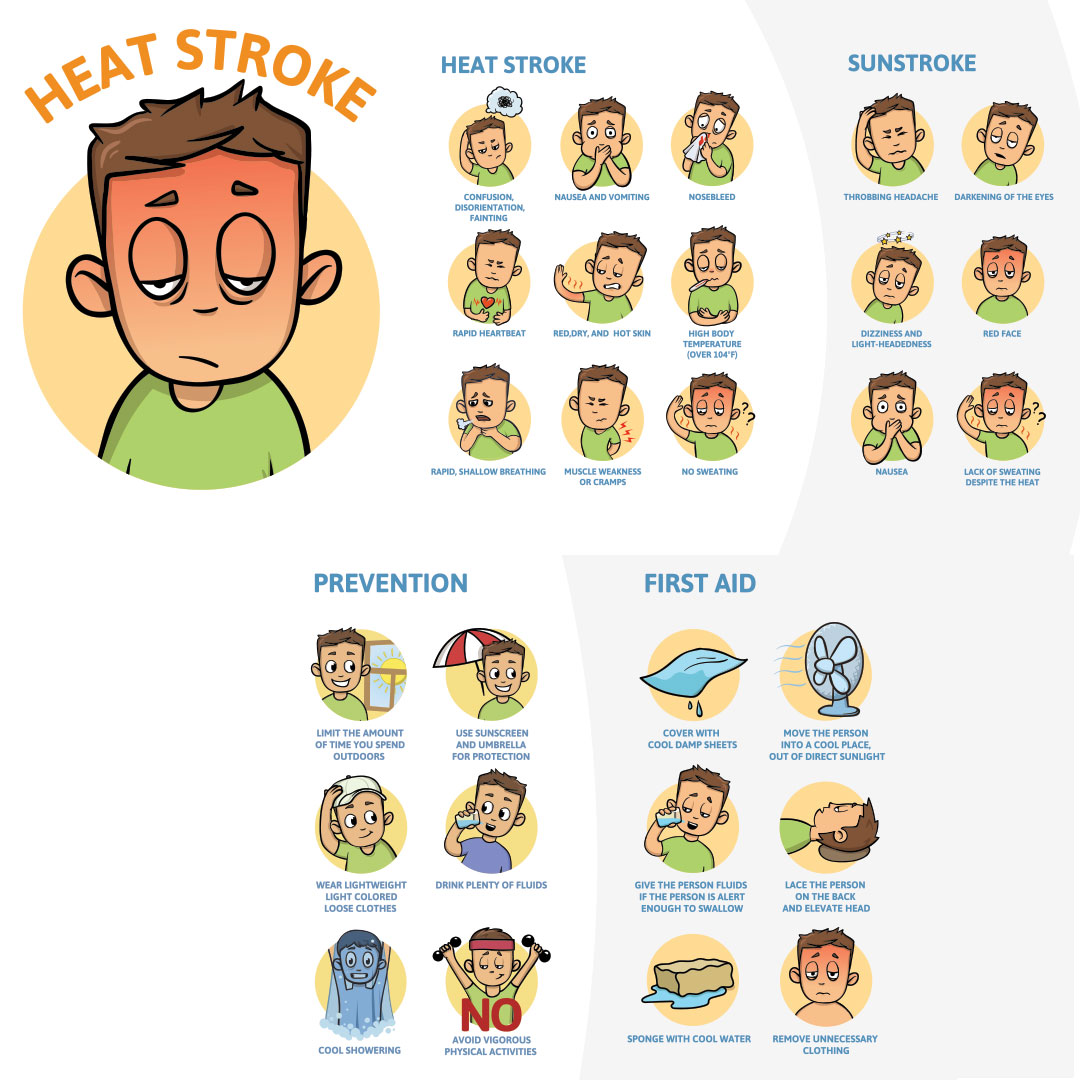
Know the signs of heat illness and administer first aid immediately!
First Aid for Heat Exhaustion
As soon as you notice the signs of heat cramps or heat exhaustion in yourself or someone else, basic first aid is needed to prevent it from escalating into heatstroke. Take the following steps:
- Move to a cooler location.
- Rest, preferably laying in a cool place with feet elevated.
- Sip slowly on a cool beverage (preferably water).
- Use a hand-fan or electric fan.
- Applying cool, wet cloth or water to the head, groin, and armpits will reduce body temperature quickly. Other “hot zones” that will cool the body off fast are the neck, ankles, behind the knees, wrists, and inner elbows.
- DO NOT USE ICE! This can create too much of a shock to the system and even result in frostbite if applied for too long. If you have cold gel packs, like those used for back pain or sprains, they are acceptable for use but monitor closely and alternate on and off of each area every 10 minutes.
If none of these steps cool you or the other person off fail to work, or you see signs of heatstroke, immediately seek medical attention by calling 911. While waiting for emergency services, DO NOT:
- Force the victim to drink more liquids.
- Allow victims to take any pain relievers, salt tablets, or other medications that may cause further dehydration.
- Absolutely never allow them to drink any alcoholic beverages, even beer. This is not rehydration, alcohol accelerates dehydration in the body.
- Don’t apply rubbing alcohol to the skin. This is an old folk remedy that doesn’t truly reduce body temperature. Even though it feels like it has a cooling effect as it quickly evaporates, it actually dries the skin out and contributes to more dehydration.
Preventing Heat Exhaustion
Luckily, there are several steps that you can take to prevent heat exhaustion. Treating the problem before it even becomes a problem is always the best way to go.
Hydration
The simplest way to begin preventing heat-related illnesses is to stay hydrated. Here are some tips on staying hydrated:
- Hydrate even if you’re not thirsty. Thirst is the first sign that you may be headed for a problem, so cut it off at the pass.
- Sports drinks are good for replacing salt and minerals lost to perspiration, but alternate them with an equal amount of water instead of relying exclusively on them.
- Very sugary drinks contribute to dehydration, including soft drinks. Again, if you choose to drink them, alternate with an equal amount of water.
-
Alcohol speeds up dehydration, as mentioned earlier. The higher the alcohol content, the more rapidly dehydration will set in. Even beer dehydrates you, and alternating with water may not be enough to keep you well-hydrated.
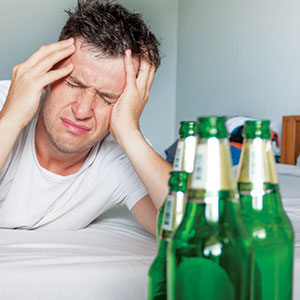
Alcoholic beverages, even beer, can lead to further dehydration.
- Avoid very cold drinks, as they can cause painful stomach cramps that may be mistaken for symptoms of heat exhaustion.
- If your doctor limits your fluids, check with them to see how much you can have in hot weather.
- Some people worry about overhydration, or “water intoxication” that leads to hyponatremia, where electrolytes like sodium levels drop too low. This typically results from being overly hypervigilant about dehydration, illicit drug use, certain health conditions, or mental illness.
This can be a real concern, especially since the symptoms like confusion and disorientation can be mistaken for heat-related illness, but most people can determine if they’ve had too much water as opposed to too little. If you’re unsure, seek emergency medical attention immediately.
How do I know if I’m dehydrated?
Thirst is the very first sign that dehydration is beginning to set in. From there, a dry, sticky mouth and/or thick white saliva will form. If ignored, this will lead to the heat-illness symptoms above. A very good indicator is the color of your urine, as shown in the chart.
-
Good, healthy colors:
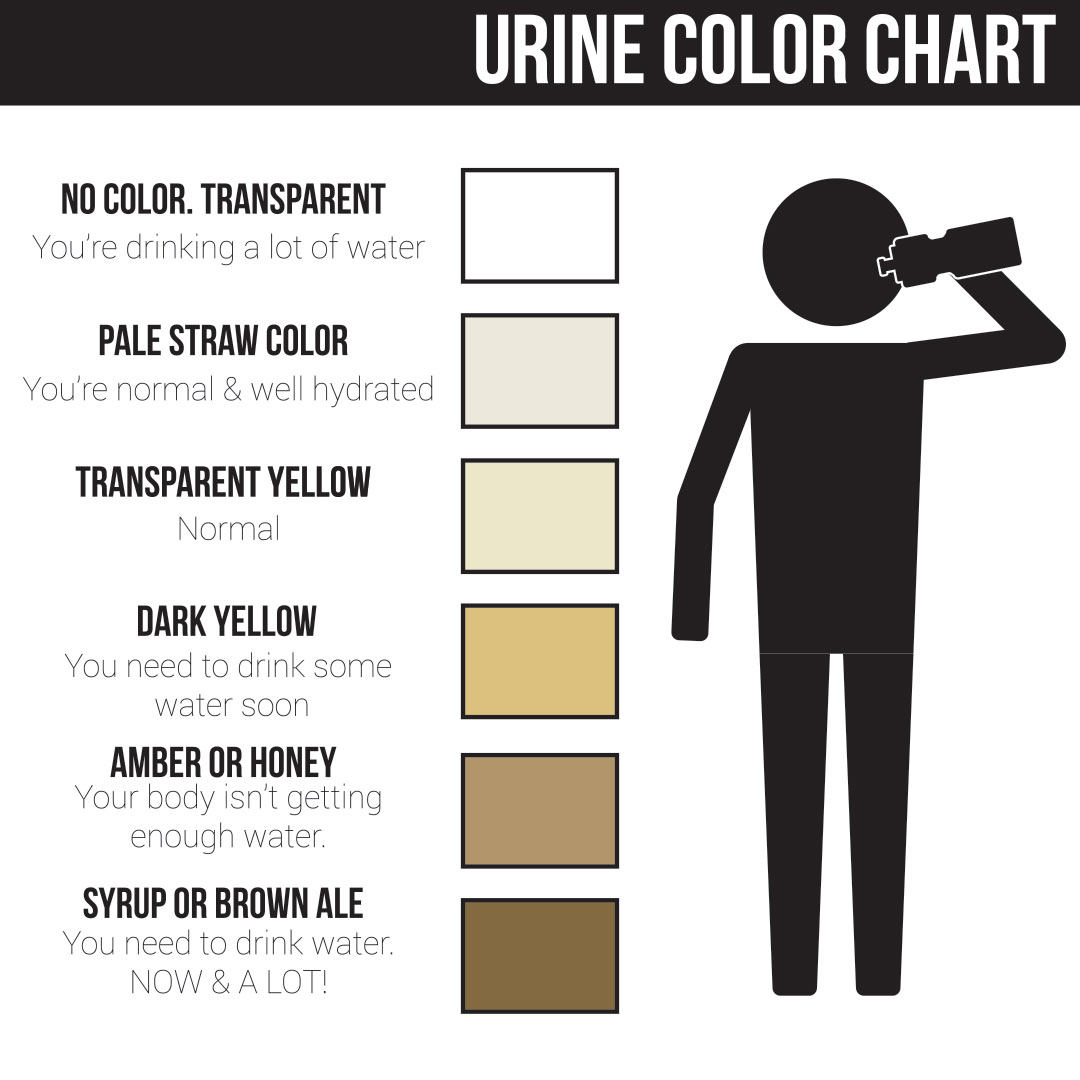
Your urine is a sure sign whether you’re hydrated or not.
-
-
- No color, clear and transparent = drinking a lot of water
- Pale yellow “straw” color = normal and well-hydrated
- Transparent yellow = normal but now would be a good time to hydrate again
-
- Colors that indicate a problem:
-
- Dark yellow = dehydration is beginning, start rehydrating soon
- Amber or honey yellow = you are dehydrated and need to rehydrate immediately
- Dark brown “ale” or syrup color = you are very dehydrated and need to rehydrate until your urine turns back to at least transparent yellow, if this color persists seek medical attention!
Dress for the Weather
Indoors or out, keep the following clothing tips in mind:
- Wear loose-fitting clothing to allow evaporation and air circulation.
- Wear lightweight clothing, and avoid heavy fabrics like denim.
- Dress in light colors, this will reflect some of the solar heat.
- Wear clothing that has a UPF (Ultraviolet Protection Factor) listed, these are specialized fabrics that are far better than sunscreen and are typically lightweight wicking garments.
- Clothing that has wicking properties, similar to base layer underwear worn in the winter, is excellent in the summer.
Stay Indoors As Much As Possible
- Stay indoors and avoid the sun as much as you can, especially between 10 a.m. and 2 p.m. or any time the temperature is 90 degrees or higher.
- Use A/C if it’s available, making sure it’s in good working order and that the filters are clean at all times.
- If it’s not available, visit public air-conditioned places like libraries, shopping malls, or public cooling stations that have been set up for this purpose.
- Fans are not cooling devices, they just move air and can give a false sense of security.
- Don’t rely on fans alone to cool your house. However, if you place a bowl of ice or frozen water bottles in front of a fan, it can provide some short-term cooling effects.
- Keep windows, curtains, blinds, and shutters closed when the sun is up.
- Consider having outside awnings or external blinds.
- Place foil-covered cardboard in windows to reflect solar heat and light.
- Blocking incoming light can reduce indoor temperatures up to 80 percent.
- Once the outside temperature drops below your inside temperature or when the sun is down, open all of your windows to release the heat and catch the breeze.
- Stay on the lowest floor to avoid sunlight and remember that cold air sinks while hot air rises.
- Cool showers or baths are perfect for hot weather.
- You can also fill the tub with cold water and wade around in it from time to time.
- Cold water takes a long time to warm up, and this will provide a little extra cooling in the bathroom, too.
- You can place clothing and similar items in the refrigerator or freezer for about 30 minutes, then take them out and put them on to cool off. Try it with your sheets before bedtime, it’s helpful for drifting off to sleep when it’s hot. Weird trick, but it really works!
- Stock up on necessities when you go out so that you don’t have to go out into the heat frequently on repeated trips.
- If you can’t afford to stock up in one large trip, try to stock up gradually as you can.
- Plan for power outages.
- Place water bottles in the freezer, if the power goes out move them to the refrigerator and keep both doors shut as much as possible.
- Remember that energy is heat!
- Turn off and/or unplug any unused appliances, including electronics.
- Turn off or unplug any electric air fresheners and extinguish any candles or incense burners.
- Change out any incandescent light bulbs for energy-saving fluorescent or LEDs
- A regular 60-watt bulb can get up to 200 degrees, but a fluorescent bulb is only 50-60 degrees, and LEDs are 35-65 percent cooler than incandescent bulbs.
- Cooking increases heat and food can help you!
- Try to minimize cooking and eat foods like fruit, veggies, and salad.
- If you can tolerate it, spicy foods temporarily bring up the body temperature enough to create sweating, particularly on the face.
- Heavy meals increase body temperature, so eat light and eat often instead of large meals.
- If you have the opportunity, cook as many meals outside as you can.
- If you must cook inside, use the microwave, minimize the use of stovetop burners, and avoid using the oven.
- Dishwashers put out a lot of heat, only run them when they’re full and hold off until nighttime.
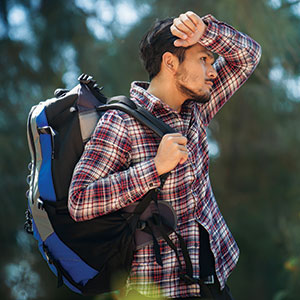
Staying hydrated during outdoor activities is essential.
Outdoor Activity in Hot Weather
- Acclimate gradually, spending a little more time out in the heat each day before you go on a trip or begin an outdoor job or project. Preferably do this over a 10 to 14 day period.
- Avoid the midday between 10 a.m. and 2 p.m., or any time the temperature is over 90 degrees.
- Pace yourself and take frequent rest breaks.
- Wear sunglasses to shade and protect your eyes from sunlight.
- Wear an appropriate hat whenever you’re outdoors for any amount of time.
- Wear sunscreen of SPF 30+ and reapply frequently.
- Preventing sunburn before it starts is important to avoid pain and risking slipping closer to heat-related illnesses.
- Optimize shady spaces and try to stay in them when working or recreating.
- If you’re in a dry climate that’s not very humid, soaking your clothes or towels (particularly cotton) in water and then wearing them is a great way to simulate the cooling effects of sweating without losing your body’s hydration.
- When camping in tents, open all of the windows and ventilation ports to allow any breeze to pass through.
- Adjust the rainfly to shade the windows so that light doesn’t come into the tent (you’ll find you need to adjust this as the day goes on and the sunlight shifts).
- Swimming is a great hot weather activity! Try to stick to places with lifeguards posted, especially if you are taking kids.
- If you choose to visit an AYOW (At Your Own Risk) swimming spot like a lake, marina, river, etc., make sure you wear a PFD (Personal Flotation Device, ex: lifevest) and go in a group. While swimming at such a place, make sure at least one person stays out of the water when others are swimming as a safety precaution.
Community & Family
- Never leave children or pets in the car! In two minutes or less, this can become a life-threatening situation. Even if you’re just “running in for a minute,” bring children inside with you and leave the pets at home if you’re going to places where they are not allowed.
- Keep track of local news & weather.
- Watch others around you and check in on neighbors, especially the elderly and others who may be vulnerable.
- Call around to friends and family to check in and make sure everyone’s okay.
- Pets:
- Keep plenty of fresh water available.
- If at all possible, keep them indoors.
- If kept outdoors, make sure they are in the shade and check on them often.
- Just like humans, even 15 minutes of being dehydrated in extreme heat can cause permanent brain damage and/or death.
No Sweat, Right?
Now that you know the best ways to stay cool, avoid heat illnesses, and provide first aid if needed, you can be comfortable and safe in the hot weather. Add your top tips and tricks in the comments below, and share this if you liked it!
- Do all 9mm bullets fit 9mm guns? 3 Popular 9mm Calibers - August 13, 2021
- Hot Weather Tips: 5 Easy Hacks - July 19, 2021
- The Bugout Bag and The Family Bugout Bag 101 - June 18, 2021
Related Posts
« 5 Benefits of Dry Fire Laser Training Systems Vortex SPARC Solar Red Dot Sight »



